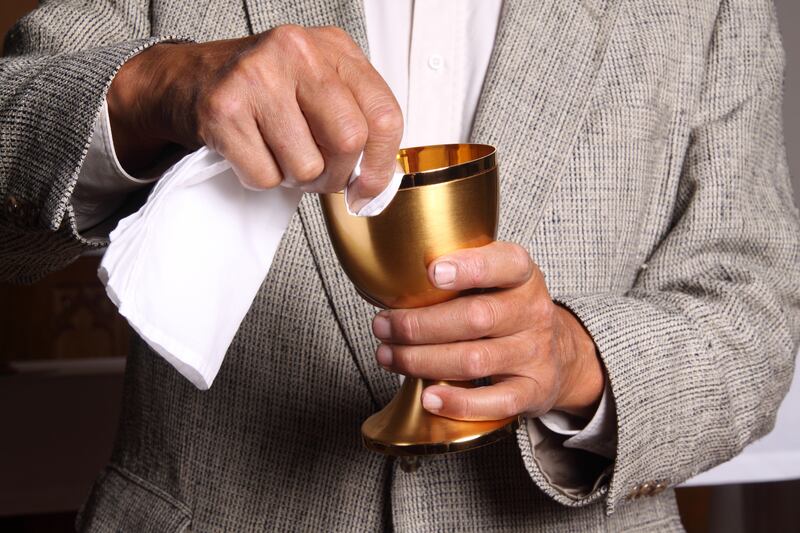Christmas is second only to Easter as the holiday most likely to attract churchgoers. In the coming weeks, more people than usual will be filing into churches big and small, and many of those parishioners will be taking Communion.

The overlap of the religious rite with cold and flu season raises an uncomfortable question: Is receiving Communion sanitary?
Many Communion practices fly in the face of the day-to-day precautions most educated adults ordinarily take to prevent illness. A recent New Yorker article chronicled how hand sanitizer has become one of the fastest growing industries in America, thanks to increased awareness and concern about the spread of germs.
Taking Communion is one of the most sacred acts of the Christian faith. Bread and wine (often grape juice, these days) are consumed as tribute to Jesus Christ, with the wine (or juice) viewed as symbolic of his blood and the bread his body, and the sacrifice he made through his crucifixion. It also serves as a remembrance of his Last Supper, hence the term the Lord’s Supper to refer to Communion.
Communion practices vary by denomination and even by individual parishes. Many evangelical churches pass trays of tiny individual cups of grape juice and a separate tray containing bread pieces or wafers, said Elesha Coffman, an assistant professor of church history at Iowa’s University of Dubuque Theological Seminary, which is Presbyterian. “Those practices did develop out of concerns about germ-sharing about a century ago,” she said.
But some churches still rely on older methods for administering the sacrament. Specifically, the cup-sharing method, in which one chalice is filled and re-used by all parishioners. (Here is a recent video of the practice in an Episcopal church. Skip ahead to around 44 minutes in.)
Debra, a New York-based lawyer who grew up in the Episcopal Church, said the practice has never bothered her. But it does trouble her children, who spent much of their early lives in the Baptist Church, where the individual-cups method is the norm. She said when they attended an Episcopal service and were asked to drink from a common cup, “They absolutely refused to take Communion,” fearing germs. When asked if the potential for germ-sharing bothered her, she scoffed: “Not at all.”
“During flu season, it’s a bad idea,”said Elaine Larson, an associate dean at Columbia University’s Mailman School of Public Health. “The problem is flu is contagious about 24 hours before there are symptoms.”
What about the evangelicals’ method, in which hundreds of people take bread from the same food tray—is that also problematic? “Theoretically, I suppose,” Larson said. “But that might be taking it too far. Unless someone was acutely ill, they’d have to have an awful lot of germs on their hands to spread them.”
With a shared cup, however, there is the possibility of spreading the flu or cold germs, or even passing on cold sores. Even wiping the cup, which is often done between those receiving Communion, doesn’t do the trick—the same cloth is wiping up after countless people.
Larson said she’s received Communion and never worried much about the health risks, despite being someone who deals with the spread of germs for a living. “I don’t think about it. A lot of more serious things to worry about.”
But she did have words of advice for churches and churchgoers. If you’re sick, it’s probably best to pass on Communion. “Although that’s probably unlikely,” for many people, she acknowledged. She also sang the praises of individual cups. “For big churches, little cups are a good idea,” she said.
Some churches have taken it a step further, by administering Communion in individual packs so that no one shares a drink or touches their neighbors’ bread.
Kirsty DePree, an associate minister at Manhattan’s Marble Collegiate Church, said her parish is conscious of germs in administering Communion. “We are mindful of flu season. Definitely,” she said. While the church uses individual cups on Sundays, during Wednesday evening services the church employs a practice known as intinction, in which each parishioner is given an individual piece of bread to dip into the cup.
But even the practice of intinction varies by congregation. Some churches consider intinction a more sanitary method, but only when done by a member of the clergy. One Anglican Church in Canada recently wrote of the practice, “Intinction is only a defense against disease if done circumspectly: The priest (with clean hands) must intinct, being careful not to touch the wine with his/her fingers, and must then place the wafer directly on the tongue of the communicant, again being careful not to touch any part of the recipient. If the communicant intincts for himself, or the priest contaminates either himself or the wine, it is pointless.”
DePree said Marble Collegiate sometimes takes another flu-season precaution. During the “passing of the peace,” when parishioners greet each other with handshakes, pastors encourage them to instead acknowledge each other with kind words. DePree said one of her co-pastors described such strategies as “our way of showing consideration for people’s health and wholeness.”
But some centuries-long traditions die hard, even for adults who normally are extremely health conscious. One possibility could simply be blind faith, but Elaine Larson attributed it to the comfort the church brings people.
People think, “We’re all good friends and want to do Communion” she said.






